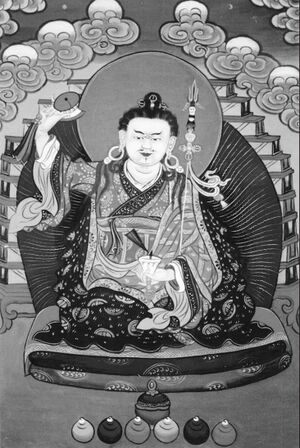Choying Tobden Dorje’s Encyclopedic Work and Buddha-Nature
In 1838, Choying Tobden Dorje, one of the leading Nyingma figures of the Amdo region, completed his encyclopedic work entitled the Treasury of Precious Sūtras and Tantras. This multivolume work is today being translated into English by Ngawang Zangpo, Gyurme Dorje, and Heidi Nevin, and published in the Complete Nyingma Tradition from Sutra to Tantra series. Choying Tobden Dorje was one of the four leading students of the first Dodrup Jigme Thinley Özer and thus a teacher of the Nyingthig tradition. Following the model of Jigme Lingpa's Treasury of Precious Qualities and Longchenpa's Treasury of Wish-Fulfilling Jewel, Choying Tobden Dorje presents the entire span of the Buddhist path in twenty-five chapters starting from following a virtuous teacher and culminating in the Dzogchen tradition of which he was a staunch advocate and practitioner.
After discussing the type of teachers, etiquette for studying, four points of mind turning, and taking refuge in the first seven chapters, Choying Tobden Dorje discusses bodhicitta and the ground Madhyamaka in the process of which he discusses buddha-nature.
- དེ་ལྟར་སྐྱབས་འགྲོའི་སྡོམ་པ་གཞི་བཟུང་ནས། །ཐེག་ཆེན་སེམས་མཆོག་བསྐྱེད་ལ་རིགས་ཁམས་དོན། །ཤཱཀྱ་ཐུབ་པས་སྣ་ཚོགས་འཁོར་རྣམས་ལ། །ལྷ་དང་ཀླུ་ཡི་གནས་ལ་སོགས་པ་ནས།། འཁོར་ལོ་ཐ་མ་དོན་དམ་ངེས་པ་བསྟན། །སྔ་འགྱུར་ཕལ་ཆེན་དཀོན་བརྩེགས་མྱང་འདས་མདོ། །གཟུངས་ཀྱི་དབང་ཕྱུག་སེང་གེ་ང་རོའི་མདོ། །བུ་མོ་རིན་ཆེན་ལྷ་མོ་དྲི་མེད་མདོ། །སོར་ཕྲེང་བྱམས་ཞུས་བདེ་གཤེགས་སྙིང་པོའི་མདོ། །ལ་སོགས་དགུ་བཅུ་གསར་འགྱུར་ཉི་ཤུ་བཞི། །དགོངས་པ་འགྲེལ་པའི་བསྟན་བཅོས་བཅུ་ཕྲག་བཞི། །དོན་དམ་བདེན་པ་བདེ་གཤེགས་སྙིང་པོ་ཡི། །སྣང་བའི་ཡོན་ཏན་སྐུ་དང་ཞིང་ཁམས་དང་། །སྟོང་པའི་ཡོན་ཏན་སྟོབས་བཅུ་མི་འཇིགས་སོགས། །ཡེ་ནས་ལྷུན་གྲུབ་འགྱུར་མེད་རང་རིག་ཁམས། །གློ་བུར་གཟུང་འཛིན་ལས་ཉོན་འཁྲུལ་པས་བསྒྲིབས། །
- Having thus the foundation of vows of taking refuge
In order to generate the thought of great vehicle
The Buddha has taught the topic of gene or element
Which constitutes the last wheel of definitive ultimate truth
To various disciples in the lands of gods and nāgas.
Among the early translations are ninety sūtras including Avataṃsaka,
Ratnakūṭa, Mahāparinirvāṇa, Dhāraṇīśvara, Siṃhanādasūtra,
Ratnadārikā, Vimalaprabhabparipṛcchā
Aṅgulimālīya, Maitreyaparipṛcchā and Tathāgatagarbhasūtra.
Among new translations are twenty-four.
There are forty commentarial treatises.
The ultimate truth that is buddha-nature
Has features of appearance such as enlightened bodies and realms
And features of emptiness such as ten powers and four forms of fearlessness.
The immutable self-aware gene, which has qualities primordially and naturally present,
Is obscured by the adventitious, dualistic, deceptive afflictions and actions.
- སྒྲིབ་ཀུན་སངས་ཚེ་དྲི་མེད་ཡོན་ཏན་རྒྱས། །འགྲོ་བ་ཡོངས་ལ་བདེ་གཤེགས་སྙིང་པོས་ཁྱབ། །རིགས་སད་རྟགས་སུ་སྲིད་ཞིའི་སྐྱོན་ཡོན་མཐོང་། །ཡོན་ཏན་རྒྱ་ཆེ་སྲིད་པའི་མཚོ་ལས་སྒྲོལ། །ཆོས་དབྱིངས་རྟེན་དང་སྣང་བ་བརྟེན་པ་དང་། །མ་དག་དག་པ་ཤིན་ཏུ་དག་པའི་རིགས་། །མར་དང་མར་མེ་ནོར་བུ་གསེར་དང་འབྲུ། །ཤིང་འབྲས་དཔེ་དྲུག་གཞི་ལམ་འབྲས་བུའི་ཚུལ། །པདྨའི་སྦུབས་ཀྱི་སངས་རྒྱས་སྦྲང་མ་སྦྲང་། །སྦུན་པའི་འབྲས་བུ་འདམ་རྫབ་ནང་གི་གསེར། །ས་འོག་གཏེར་དང་ཤུན་པའི་མྱུ་གུ་དང་། །གོས་རུལ་ནོར་བུ་མངལ་གྱི་མི་བདག་དང་། །ས་ཡིས་བཏུམ་པའི་གསེར་སྟེ་དཔེ་དོན་དགུ །དབྱིངས་དང་སངས་རྒྱས་སྙིང་པོ་ཁམས་དོན་དམ། །འོད་གསལ་སྟོང་ཉིད་ཤེར་ཕྱིན་དེ་བཞིན་ཉིད། །ཁམས་ཡོད་མོས་པ་ཕྱོགས་རེ་མངོན་གྱུར་པ། །སྐྱོན་དང་འདུས་བྱས་ཀྱིས་སྟོང་ཡོན་ཏན་རྫོགས། །ཉེས་པ་ལྔ་སེལ་སྤྲོ་བརྩོན་གཞན་དོན་འགྲུབ། །
- When the obscurations are cleared, the stainless qualities shine.
The buddha-nature pervades all sentient beings.
As signs of awakening, flaws of saṃsāra and qualities of liberation are seen.
The qualities, being vast, will deliver beings from the ocean of existence.
The sphere of reality is the support and appearance is what is supported.
The gene comes in impure, pure, and very pure phases.
Six analogies of butter, lamp, gem, gold, grains, and fruits
Illustrate it in relation to the ground, path, and fruition.
Nine analogies showing the point are a buddha image in a bud,
Honey within the bees, grain in the husk,
Piece of gold in the mud, an underground treasure,
A shoot in the bark, a gem in a rag,
A monarch in the womb, and gold covered by earth.
It is the sphere, the essence of buddhas, the element, the ultimate,
The luminous, emptiness, perfection of wisdom and reality.
The element is believed to exist, seen partially, and fully realized.
It is empty of flaws and conditioned things but complete with enlightened qualities.
It removes the five faults, and inspires interest, diligence, and benevolent actions.
He unpacks these concise verses on buddha-nature, as with the rest of the treatise, through a summary, a word-for-word commentary, and then an elaborate exegesis which fills five volumes in its most recent publication by Sitron Mirig Petrun Khang.
Weekly quote
~

